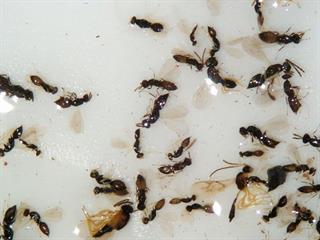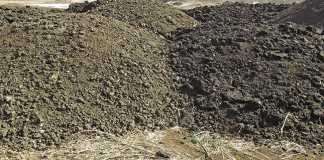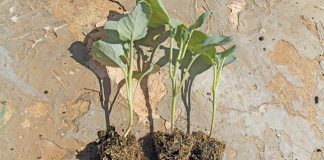
It prefers a milder climate and is more suited to the Highveld than South Africa’s subtropical areas. Although lettuce is a fast-growing crop, the pea leaf miner is even faster. It has a life-cycle of about 15 days, and can quickly destroy a crop. The species is also partial to spinach, peas and potatoes.
When it first made its appearance in this country, it caused widespread panic as it was already resistant to several commonly used insecticides. Additionally, at the time, we did not understand how parasitoids (parasitic wasps) could help control leaf miners.
The insecticides initially used to combat the new pest eradicated the parasitoids that prey on the various species of leaf miner, resulting in severe crop damage.
On my own land, L. huidobrensis destroyed newly emerged pumpkin plants because the larvae attacked the leaves and the stems of the young plants.
The pest also riddled my beans. However, I was using Abamectin for control. This is less harmful to parasitoids, and I soon noticed the presence of a number of different species of the wasps. These eventually took control, and that was the last time I had any problems with leaf miner.
Spraying changes caused by leaf miner outbreak
We are fortunate to have these parasitoids, which occur naturally due to the presence of other leaf miner species. It took time for them to breed up into the population of the new leaf miner species, but eventually even farmers who were sceptical about the wasps’ ability to control the pest were won over.
Indeed, some farmers told me the pea leaf miner outbreak was a blessing in disguise. Before this, they would simply spray their crops with harsh chemicals on a weekly programme to get rid of all pests. L. huidobrensis forced them to change their approach.
Not only did they switch to using softer products, but they also became more knowledgeable about what they were spraying and why. Nowadays, most spray only when necessary, and practise biological pest control. This means less money spent on chemicals, and fewer tractor hours.
The leaf miner will always be around, but as long as we use chemicals that allow parasitoids to thrive, it will be kept in check. I occasionally see the odd serpentine tunnel in a leaf, but know that it is no longer a threat to my produce.
If needed, you can get away with using a harsh chemical now and then without causing a flare-up; however, with the number of safe products now on the market, it is not worth the risk.
Western flower thrip
Thrips are generally not a major lettuce pest and you are unlikely to need to spray to prevent physical damage from this pest. The problem is that with the accidental introduction of the western flower thrip (Frankliniella occidentalis), we now have a vector for spotted wilt to which lettuce is susceptible.
I have seen outbreaks that have rendered a high percentage of the crop unmarketable. As spotted wilt can survive on many susceptible weeds, keep the verges of lands free of weeds when growing lettuce.
Stop the spread in the land by removing infected plants. If too many become infected, spray with a suitable insecticide.
Bill Kerr is a vegetable specialist and breeder of a range of vegetables.













